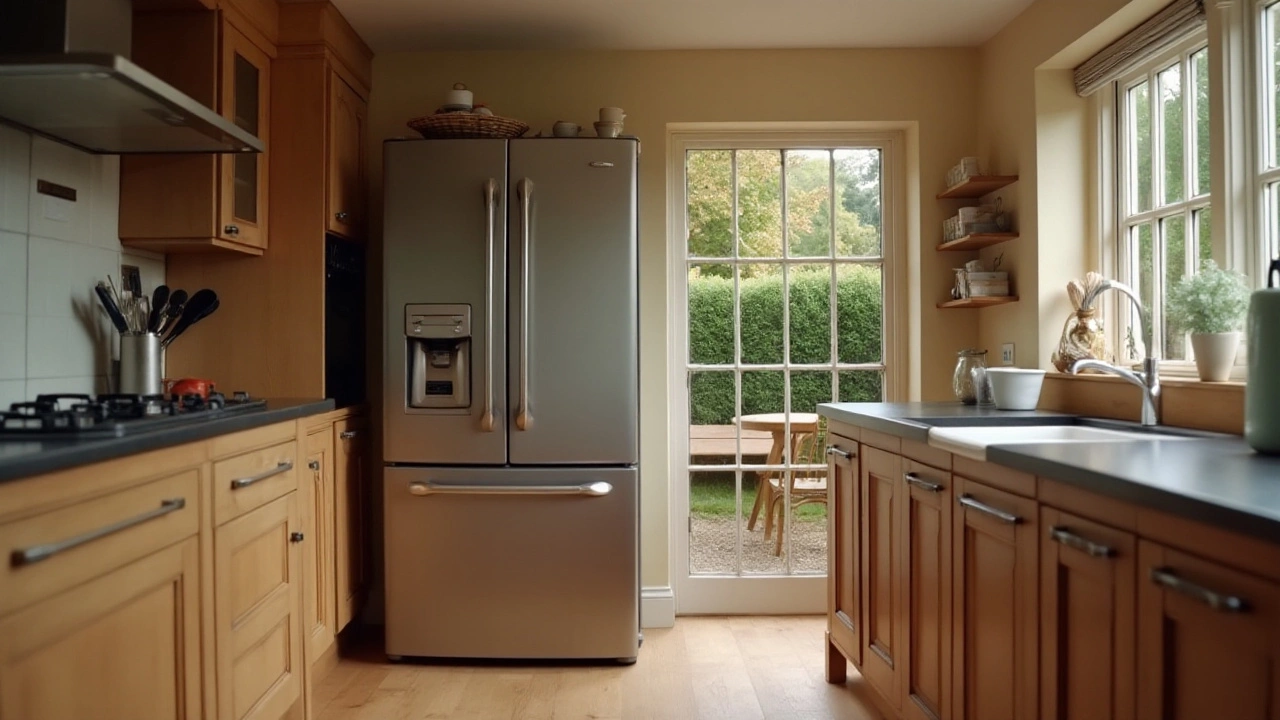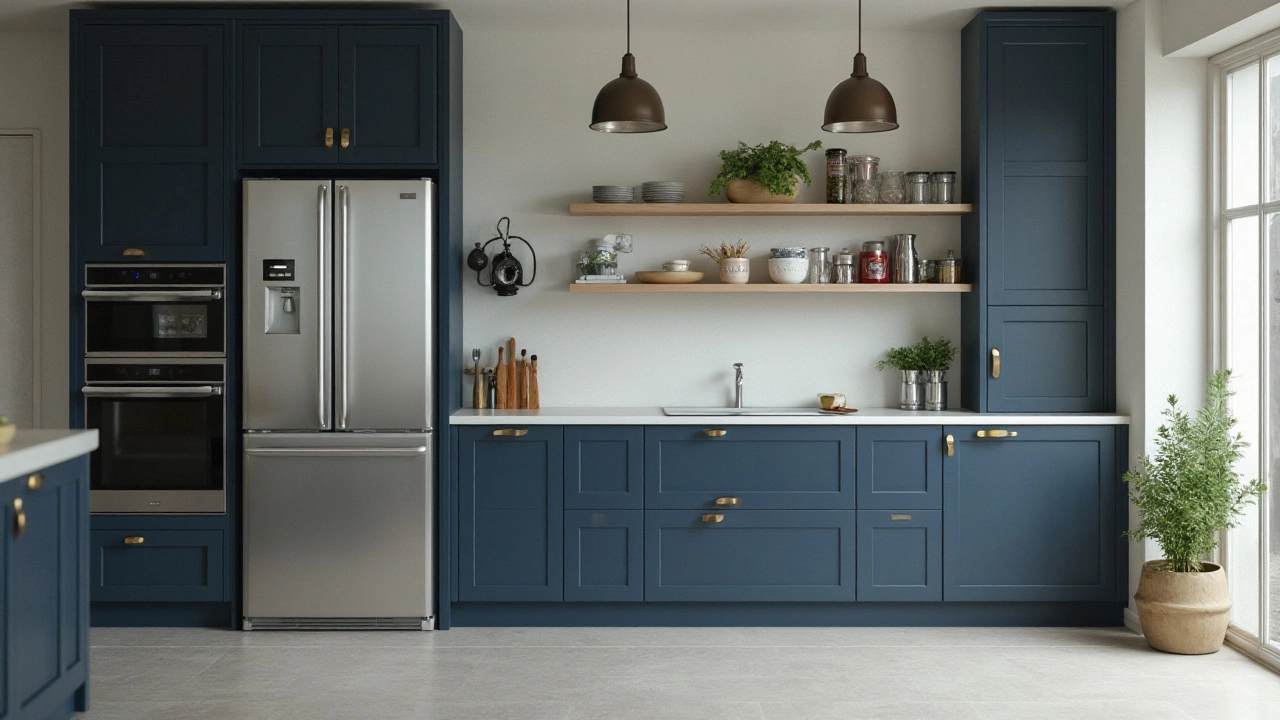When it comes to kitchen design, one often overlooked element is the placement of your refrigerator in relation to the cabinets. This might seem like a minor detail, but it can significantly impact both the look and functionality of your kitchen. A common question among homeowners is: how far should a refrigerator stick out from the cabinets?
Many refrigerators are designed to protrude slightly beyond the cabinets. This is primarily a function of standard fridge dimensions versus standard cabinet depths. However, the decision on how far a fridge should extend is not just about measurements. It's also about creating a balance between style and practicality in your kitchen space.
- Understanding Standard Refrigerator Design
- Aesthetic Considerations
- Functionality and Accessibility
- Customizing Your Kitchen Layout
- Practical Tips for Optimal Refrigerator Placement
Understanding Standard Refrigerator Design
When diving into the world of refrigerator placement, it's essential to grasp the core principles of standard refrigerator design. Most refrigerators are built based on historic kitchen layouts, aiming to balance both design norms and practical use. Typically, a standard refrigerator is about 30 to 36 inches deep. This measurement often excludes the necessary space for door clearance, handles, and air circulation at the back to ensure optimal performance. Detailed, isn't it?
A critical factor influencing how much a refrigerator sticks out from kitchen cabinets is the cabinet depth themselves, which usually measure around 24 inches. This discrepancy results in many models protruding beyond the cabinetry by at least six inches. It's not just a matter of appearance, though; the extra space allows room for the doors to open adequately without colliding with adjacent cabinetry or walls.
According to a leading appliance expert, "The evolution of refrigerator dimensions has long been a dance between ergonomic function and kitchen aesthetic." This balance becomes evident when considering the modifications in design as lifestyles have shifted towards more open kitchen concepts.
While you might find some built-in or counter-depth fridge models that aim for a more flush appearance with the cabinets, these often come with trade-offs in functionality and accessibility. Counter-depth models, for instance, typically offer less interior space because of their shallower build, which can be a consideration for large families or those who frequently entertain. They are designed to align more closely with your kitchen counter depth, thus giving kitchens a streamlined, seamless appearance without significant protrusion.
Another intriguing detail is how energy standards play into design. Modern refrigerators often incorporate advanced cooling systems and insulation, a factor that occasionally requires additional depth to house the technology effectively. Innovatively, some brands have engineered solutions where external dimensions remain compact without sacrificing interior space, showing that the industry is actively responding to consumer needs for both efficiency and aesthetics.
If you've got the room and budget, another option is customizing the surrounding cabinetry to accommodate your specific fridge model, which can truly merge form with function. This approach allows you to tailor-fit the kitchen layout to your lifestyle, marrying convenience with design in perfect harmony. However, keep in mind the potential costs involved when opting for custom solutions, which can be significantly higher than sticking with traditional setups.
| Component | Dimension |
|---|---|
| Standard Fridge Depth | 30-36 inches |
| Standard Cabinet Depth | 24 inches |
Considering these aspects, knowing how and why standard refrigerators are designed the way they are can greatly assist homeowners in making informed decisions on refrigerator placement, thereby enhancing the functionality and visual appeal of their kitchen design.
Aesthetic Considerations
Your kitchen is the heart of your home and achieving the right balance between functionality and beauty is essential for creating a space you love. The amount a refrigerator protrudes from your cabinets impacts not only the visual appeal of the kitchen but also the mood you aim to set. Making thoughtful choices about this can transform a good kitchen into a great one.
Designers usually recommend that a refrigerator placement aligns closely with the surrounding cabinetry to create a seamless appearance. This means opting for counter-depth refrigerators designed to be roughly the same depth as your countertops and cabinets. This alignment creates clean lines, offering a built-in look that is highly coveted in modern kitchen design. The feeling of continuity that this creates can make even a compact kitchen feel more spacious. Aesthetically, it can bring a sense of cohesion, which is often associated with high-end kitchen design.
Choosing how far the fridge should extend also depends on whether you prioritize traditional aesthetics or modern convenience. For those in favor of a more traditional look, it's common to have the refrigerator stick out a bit—this was historically popular before the advent of sleeker, integrated designs. Some people enjoy the nostalgic feel of this setup; it reminds them of cozy kitchens of the past. Others find this interruptive to flow and opt for kitchen layouts that prioritize minimalism and modernity by having everything flush.
Light reflection on surfaces is another important aspect to consider. Shine and reflection can be influenced by surfaces the refrigerator may or may not align with. When your refrigerator beautifully fits within the cabinetry, it allows the reflections of light to distribute more evenly across the surfaces, creating a brighter, airier space. It should be noted that a glossy or matte finish on the fridge can further amplify or mute these effects, depending on your preference for vibrancy or subtlety.
If opting for a protruding fridge, the depth of countertops and proportions of surrounding cabinetry can cleverly disguise some of the aesthetic impact by drawing the eye away from the appliance itself. In such cases, integrating decor elements like wall paints, backsplash continuity, or using the top of the fridge creatively with plants or baskets can redirect focus.
As kitchen designer Jane Lockhart often emphasizes, "The key to great design is capturing the spirit of the client and the essence of the space."
In cabinet design, adding cabinet panels to the side of the refrigerator can help blend it more seamlessly into the kitchen layout. Some homeowners opt for this tailored approach, which can make any kitchen look more custom and refined. While this solution is more costly, the investment often pays off in both aesthetics and resale value, as potential buyers will likely appreciate the thoughtfulness of the design.

Functionality and Accessibility
When deciding on how far your refrigerator should extend from the line of the cabinets, one of the most crucial considerations is functionality intertwined with accessibility. A neatly placed fridge that is flush with your cabinets provides a sleek and modern look, but this choice shouldn't undermine the functionality. Ensuring that the doors open freely without obstruction is important—both for ease of use and for the health of your fridge. Hedging too closely with your fridge placement can inhibit airflow around the appliance and, over time, affect its efficiency. In kitchens where space is at a premium, it’s necessary to balance the charm of an integrated look with practical considerations like how often and how easily you can access the contents inside the fridge.
Incorporating practical space around the fridge also boosts accessibility. Busy kitchens often see multiple hands reaching for the refrigerator simultaneously, and having ample space for people to move around without bumping into corners or each other is paramount. Wide door swings are combatable with a fridge that protrudes a bit beyond the cabinet line, ensuring that crispers and deli drawers can glide out without catching on anything. As noted by Jane on Kitchen Solutions Magazine,
“A well-placed fridge can often define the harmony between cooking and socializing; it serves as the fulcrum of a coherent kitchen experience from prep to plate.”
In terms of dimensions, a common guideline is leaving at least two inches of clearance from the back wall. This helps maintain efficient operation by allowing heat to dissipate properly. Different refrigerator models may require varying degrees of clearance at the top and sides, so checking the manufacturer's guidelines is a must. In small spaces, a deeper counter-depth refrigerator might seem appealing, but it’s often not practical. A compromise can be found in false cabinet panels to simulate a built-in look without sacrificing utility. For those looking to make a design statement, French-door style refrigerators make for convincing counter-depth illusions while offering significant internal storage flexibility.
Venturing into custom design provides opportunities to solve these layout puzzles while keeping kitchen design foundations in mind. Builders and designers today often utilize computer-aided design (CAD) tools to map out kitchens, ensuring refrigerator functionality and accessibility match real-world needs. With these modern tools, they may simulate how both individuals and families will interact within the kitchen space highlighting potential problem areas before any real remodeling begins. Incorporating movable or revolving shelving inside cabinetry can also decrease the need for awkward fridge locations as it brings stored items to the forefront.
Kitchens with a focal point on social gatherings will particularly benefit from strategically placed fridges. Some professionals recommend placing the fridge near the outer reaches of the kitchen to keep guests from entering your immediate cooking space. This arrangement keeps the cooking flow uninterrupted while still granting easy access to refreshing beverages and snacks, creating a harmonious dance between food preparation and social interaction. These considerations elevate both the aesthetic alignment and practical execution of your kitchen layout.
Customizing Your Kitchen Layout
When you're customizing your kitchen, the layout can make a world of difference, especially when it comes to the placement and protrusion of your refrigerator. The goal for many homeowners and designers is to create a harmonious space where functionality meets aesthetics. A refrigerator that sticks out too far can disrupt the flow and visual harmony of your kitchen. This is why it's important to plan your layout with care and consider alternative options if a standard-sized refrigerator does not fit seamlessly into your space.
Consider investing in counter-depth refrigerators. These models are engineered to align more closely with your cabinetry, offering a more integrated look. Though they may sacrifice some storage capacity, their design can create an uninterrupted line in your kitchen, enhancing the visual appeal. It's a trade-off between the additional interior space of full-sized models and the sleekness of counter-depth options. Choosing a refrigerator shouldn't just be about size and space management; it should reflect your lifestyle and cooking habits too. A bigger family might prioritize storage space over style, while a smaller household might favor seamless integration.
Innovative design techniques, such as planning for a recessed refrigerator alcove, can also help achieve that custom, built-in look. This means extending the depth of the wall behind your fridge to let it sit flush with your cabinetry. It's a practical approach that doesn't compromise the appliance's functionality or accessibility. Of course, such modifications might require more extensive renovations, but they could be well worth the investment. Between DIY projects and professional kitchen remodels, there are myriad ways to optimize your layout.
When customizing, always keep future needs in mind. If resale value is important to you, choosing a layout that accommodates different refrigerator sizes can be beneficial. Modular kitchen designs, which allow for changes as your family grows or your lifestyle changes, can be especially advantageous. But even within these flexible layouts, making sure your kitchen design is practical and comfortable remains paramount.
Expert Insights on Kitchen Layouts
"When designing a kitchen layout, think beyond the present. Consider the space's evolution over time. Prioritizing a dynamic design ensures less hassle when it comes time to upgrade your appliances or change your kitchen’s look entirely." — Laura Smart, Interior Designer
It's also worth considering complementary design elements, such as custom cabinetry and creative paneling, to help camouflage the refrigerator. Integrated panels can transform a functional appliance into a coordinated element of your overall design theme. Look at your kitchen as a holistic space where each component plays a significant role, not just in utility but in creating a balanced aesthetic.
In conclusion, customizing your kitchen layout requires a blend of strategic planning and creative design choices. By considering the placement and protrusion of your refrigerator, and how these elements interact with other parts of your kitchen, you can create a welcoming and efficient space perfectly suited to your needs. Remember, the kitchen is a heart of activity and socialization—make sure the layout reflects the comfort and style you wish for your home.

Practical Tips for Optimal Refrigerator Placement
Finding the right spot for your refrigerator might seem like a straightforward task, but it demands thoughtful consideration to ensure your kitchen design remains both beautiful and functional. Firstly, one must address the most pressing facet: space management. Indeed, one crucial measure is how far the refrigerator sticks out from the cabinets. This often-standard protrusion accounts for airflow, allowing the refrigerator to function efficiently and prevent overheating. An average protrusion of two to three inches is common, offering a balance between operational needs and aesthetics. Yet, some homeowners prefer refrigerators aligned flush with cabinets for a sleek look, especially in more compact kitchens.
Another vital tip is to consider the ease of use. Ensuring that there's ample space to comfortably open the fridge doors and access the contents without obstruction can make daily use much more convenient. The arrangement should consider the proximity to counter spaces and the main cooking areas, promoting a seamless workflow while preparing meals. Larger kitchens might offer more freedom in placement, but for smaller ones, like those found in urban settings, the refrigerator often needs to fulfill multiple roles without being intrusive.
"Home kitchens should reflect more than trends; they should cater to comfort and utility," suggests interior design expert Jill Baker, emphasizing the need for balance in design and the practicality of appliance placement.
If you're in the planning stages of building or renovating your kitchen, custom cabinetry can be designed to accommodate the fridge dimensions precisely, sometimes offering the appearance of a built-in unit. Custom cabinets also make it easier to integrate appliances without sacrificing style, allowing for smaller protrusions that fit harmoniously into your kitchen's design narrative.
Considering the distance from electrical outlets and water lines (for refrigerators with water and ice dispensers) can save time and additional expenses during installation. Safety is another aspect to factor in when deciding on positioning. Keeping the refrigerator away from direct sunlight and heat sources like ovens can extend its lifespan and improve energy efficiency. A well-ventilated spot is preferable to enhance the refrigerator’s performance, ensuring it runs efficiently with minimal strain.
Moreover, visual balance plays a critical role. The refrigerator, often a large appliance, should not dominate the kitchen landscape. It’s essential to maintain harmony by balancing it with other elements such as color themes, countertop heights, and cabinet designs. The refrigerator placement can also influence paths in and out of the kitchen, even affecting how other kitchen doors function, a crucial detail to consider to prevent cramped settings.
Grainger and Johnson's recent study on kitchen ergonomics highlights that an ideally placed fridge can reduce the time spent gathering ingredients by up to 30%. This efficiency not just adds to the cooking convenience but also improves kitchen camaraderie, making food preparation delightful.
Finally, personal preference should guide these technicalities. Your daily routine, accessibility needs, and even culinary habits will guide the ultimate decision on where your refrigerator sits. Whether aligned with your cabinet design goals or set back hoping to highlight other kitchen features, the choice sets the stage for your home kitchen to become both showcased and practical, stimulating daily culinary adventures with ease.


